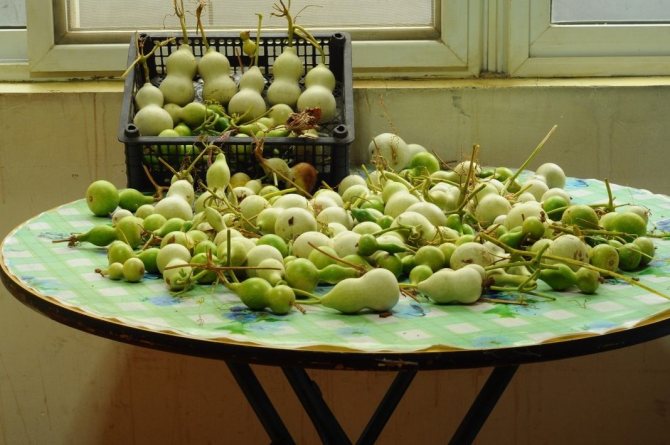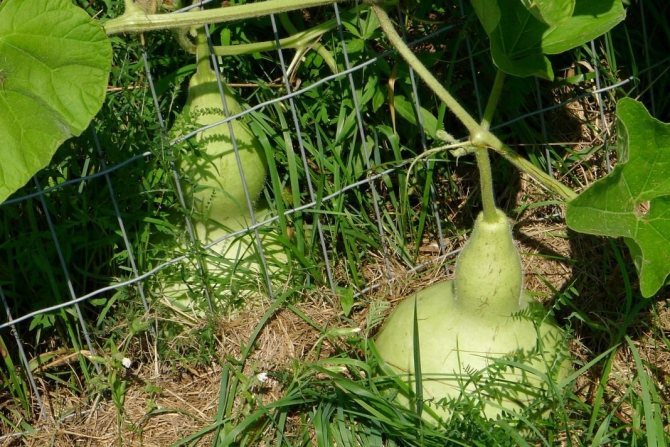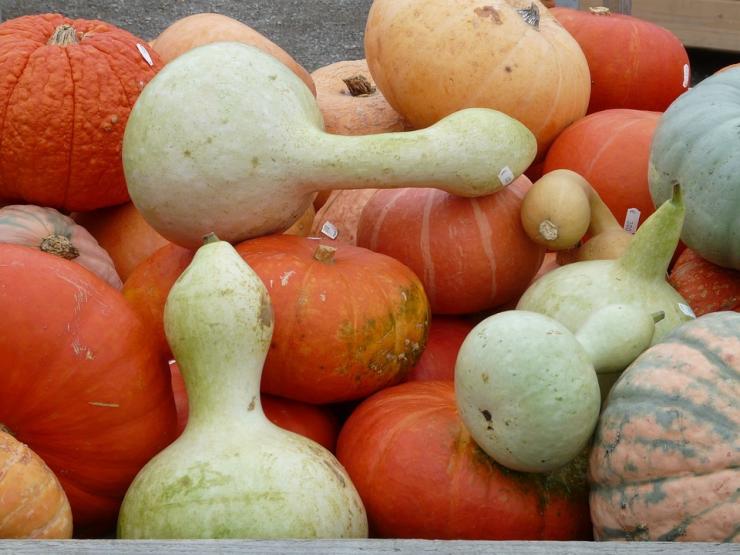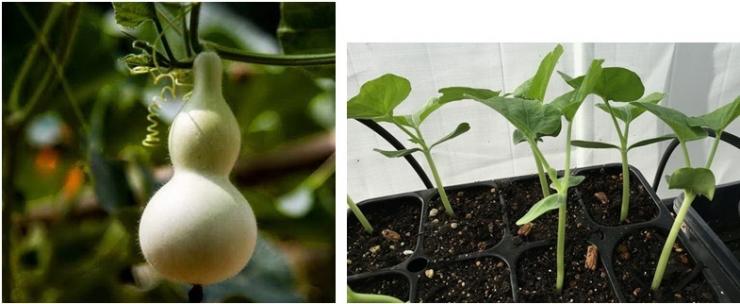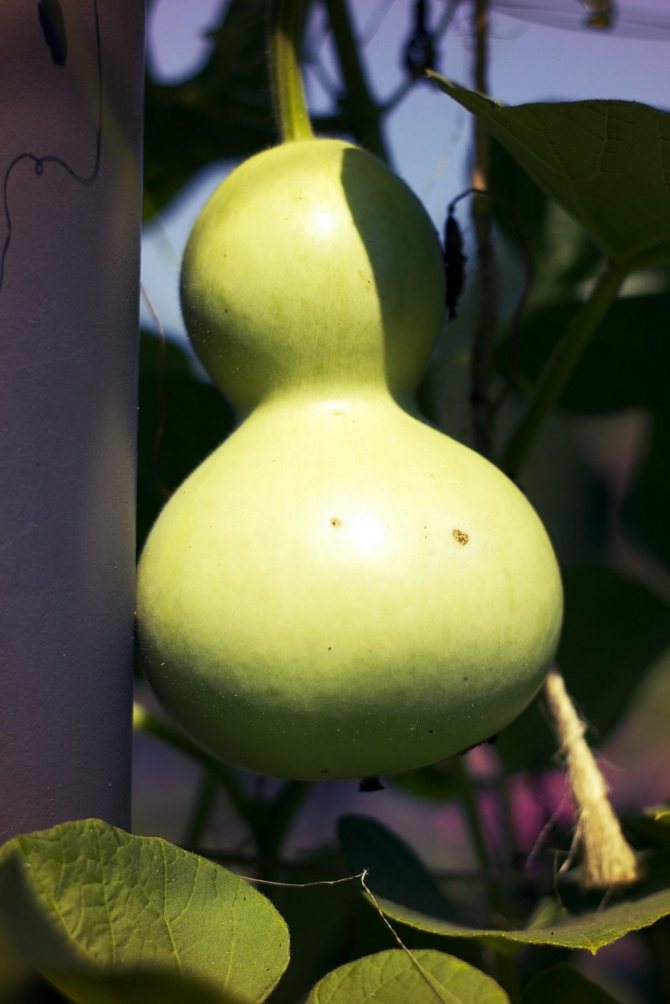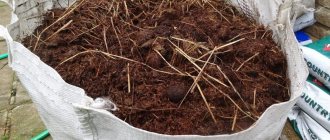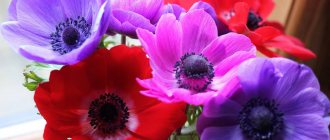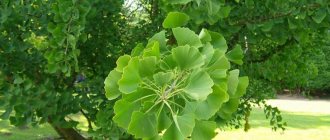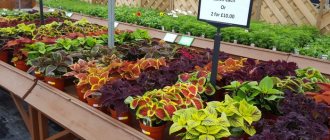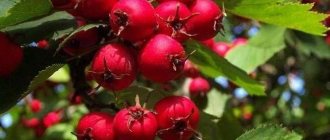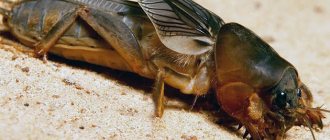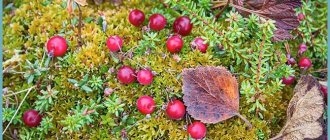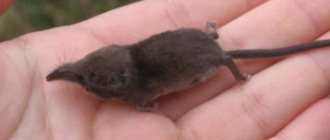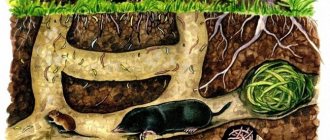How many names this vegetable has - Lagenaria, Gorlyanka, Calabas, Indian cucumber, and Vietnamese zucchini. The birthplace of this interesting culture is India. Even the ancient Romans made various dishes from the fruits of Lagenaria. Inhabitants of Africa, Asia, Latin America and the Pacific Islands still use them for the manufacture of smoking pipes, dishes, musical instruments and toys. The long flexible stems of the lagenarius are used in weaving. Oil is obtained from the seeds of the Lagenaria. Unripe fruits are eaten.
In our country, lagenaria is not widespread among gardeners, although there are amateurs who use grown young fruits for food, and use well-ripened fruits to make boxes, ashtrays, vases.
Lagenaria vulgaris, or Gorlyanka, or Calabas (Lagenaria siceraria) - an annual creeping vine of the Pumpkin family, a species of the genus Lagenaria (Lagenaria). Cultivated for the fruits that are used for a variety of purposes.
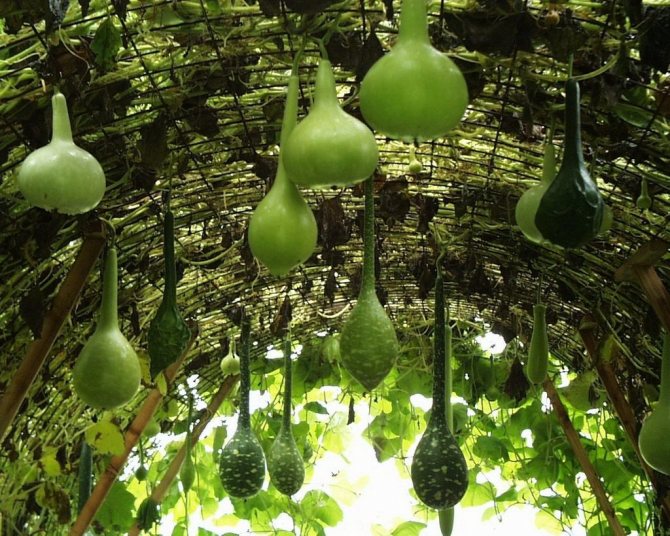
Lagenaria (Lagenaria).
Description of Lagenaria
Lagenaria vulgaris is an annual liana of the Pumpkin family. In natural conditions, it lives in Latin America, India, on the African continent. It has long creeping stems, is characterized by rapid growth - in two weeks the lashes can stretch 1.5-2 m. The leaves are 5-sided, corrugated, rough and slightly pubescent.


Lagenaria vulgaris - a representative of the Pumpkin family
It blooms like a pumpkin, with small tubular flowers of white or cream color, located singly in the axils of the leaves. An interesting feature is that the flowers open up and exude aroma only at night, and begin to close at dawn. Lagenaria fruits are also similar to pumpkins, but are more varied in shape, size and color.
Varieties and types of crops
All varieties and hybrids of Lagenaria are divided into two groups - edible and decorative. Each group has outstanding representatives.
Calabaza
An ornamental variety, surprising in the shape and size of the fruit. Scourges reach 15 m. Fruits are pear-shaped, green in color, reach 45-40 cm in length, however, two-meter pears are not uncommon. It is from such fruits that large vessels and jugs are made.
Bottle
A compact decorative variety. The lashes grow by 3 m, the maximum length of the fruit is 70 cm, the shape resembles a jug, but with a fairly wide upper part. The color of pumpkins is pale green or white.
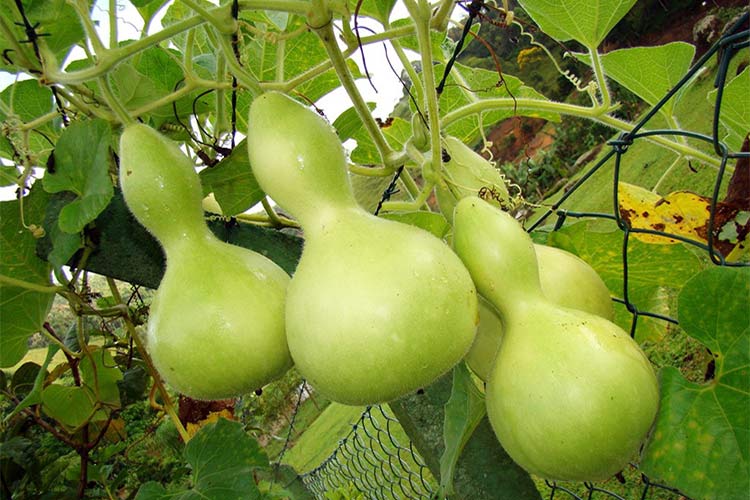

Bottle - a compact decorative variety
Polenoid
Edible species with fruits resembling young squash in appearance and taste. The bush itself is branched, the leaves are similar to pumpkin leaves, the fruits are large, at full maturity they reach a weight of 10-15 kg, the peel is light.
Serpentine
An amazing variety with very long, light green fruits that curve like a snake. In terms of taste, the serpentine variety is similar to the previous one. However, the fruits themselves are smaller - 5-6 kg with a length of 70 cm.
Cobra
The variety stands out for its unusual mottled color and intricate shape of the fruit, in which there is a noticeable thickening in the lower part, and in the upper part there is a thin curved "neck", like a snake. The fruits have excellent taste.
Goose in apples
Another edible variety that looks very decorative. The fruits are similar in shape to the Cobra, but their "neck" is thinner and more curved.For this feature and spotty color, the variety was named Goose in apples.


Edible variety Goose in apples
Swan
Outwardly, the Swan is similar to the previous variety, only its "neck" is bent to the side and, as it were, raised up. The variety is considered decorative and is not eaten, but long vines are often used in vertical gardening.
Swan geese
Another related "goose" variety. The fruits practically do not differ externally, but the bush is very compact, the length of the whips does not exceed 1.5 m. Ripe pumpkins are used for souvenirs. Young fruits taste good.
Hostess
This variety is characterized by a variety of forms - the fruits can be in the form of pears, cylinders, bottles with a flat and elongated with a thickening in the upper part of the "neck". The color is light salad or green with a spot.
Cylindrical
This variety is something averaged between the Serpentine and Polenovidny variety. The fruits are also long, but even, bright green or salad-colored. When young, their pulp is very tender and tasty.
Warty
Rarely cultivated variety due to low fruit attractiveness. Their color and shape are standard, like those of a squash, but the surface is completely covered with small growths that look like warts.
Club-shaped
The fruits of this lagenaria resemble a club in shape - they are wide at the bottom, and taper at the top. They grow to an impressive size - about 2 m in length, the color is pale, like a vegetable marrow. The club-shaped variety is cultivated for decorative purposes only.
Turban
The most decorative variety with miniature mushroom-shaped fruits. Pumpkins have a light “stem” and “cap”, which, when fully ripe, takes on a bright orange color.
Quote post by tgkh
Vietnamese zucchini LAGENARIA (in some sources LAGENARIA, in others LAGINARIA ...)
Another exotic that occupies my thoughts. I really want to grow on the balcony.
I heard about him from my friends a long time ago. It seems that the reviews were very positive. The main difference of this zucchini is its size, that is, incredible length, and the fact that it is not at all necessary to remove the entire fruit - it is enough to cut off the necessary piece, and the remaining "stump" continues to grow and develop as if nothing had happened.
There is also a lot of green mass on the Lagenarii. And it grows like undermined - quickly. This is what I need.
The shell on the seed turned out to be really very dense, as they say on the internet. Soon a week will pass, and the seeds do not germinate ... Next time, before starting germination, I will definitely make an incision on the rib.
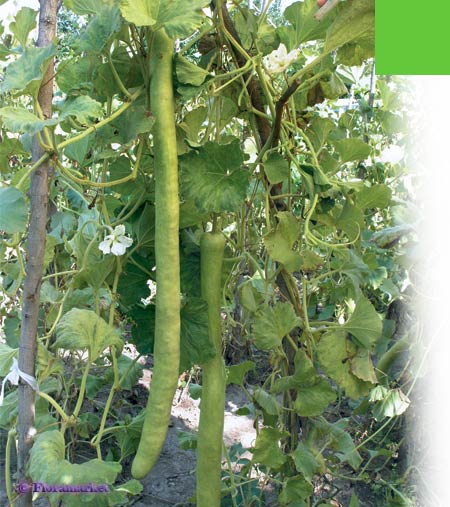

... to be honest, doubts that were initially vague are becoming more and more apparent every day. If all overseas lianas (lagenaria, Chinese cucumbers, vigna), along with asparagus beans, tomatoes and various other flowers just start to rage, no one will be able to enter the balcony. I'll have to crawl. On their bellies ... In my opinion, too much will turn out ...
GROWING LAGENARIA (Vietnamese squash) IN OPEN GROUND
This amazing plant has received a great variety of popular names: Vietnamese zucchini, Indian cucumber, giant cucumber, sauce zucchini. Lagenaria is called Indian cucumber and Vietnamese zucchini. Lagenaria is an original annual exotic plant of the pumpkin family, which grows naturally in India and Africa. This plant is a liana with large rounded, velvety leaves from soft pubescence, the daily growth of which, under favorable conditions, is up to 10 cm. Leaves can be whole or 3-5-lobed. The shoots are powerful, reaching a length of several meters. Large goblet flowers on long pedicels look very impressive. Flowers are pale pink in the morning, white in the evening. The flowers are dioecious, therefore pollination of female flowers is necessary for fruit setting.
The fruits of this amazing plant do not rot if you cut a piece and leave it hanging on the bush. The slice of the remaining part will quickly overgrow with film and the fruit will continue to grow. As the fruit ripens, its pulp dries up, and the skin turns into a hard and strong bark, from which the aborigines make very strong dishes. The fruits of lagenaria, which have a smooth surface with white, eventually disappearing, pubescence, depending on the selected variety, can be of various shapes: serpentine, clavate, pear-shaped, log-shaped, etc. In addition, fruits can be shaped at will by placing the ovaries in wooden molds that will be filled with the growing fruit.
Lagenaria is a fruitful plant, from one bush you can get up to 40 kg of fruits, each of which can reach a length of 2 m, and their average weight is 6-8 kg. The size of the fruit is regulated by the pinching of the lateral shoots and the number of ovaries left on the plant. Do not let the "cucumbers" outgrow, as only fruits of technical maturity with thin green skin and delicate pulp 50-60 cm long are eaten.
So, what do you need to know about the agricultural technology of such a wonderful plant?
In the open field, caring for lagenaria is similar to caring for a pumpkin that is very widespread in our gardens. It grows well and bears fruit both in the garden and in a room on a light south window, balcony, loggia. The plant is thermophilic, therefore, in the open ground and on the balcony in the middle zone and the North-West, it is grown only through seedlings and pleases its owner with fruits and lush greenery before autumn frosts. In addition, the plant is resistant to pests and diseases. For growing at home and on the balcony, you need to take large-capacity dishes, at least 10-15 liters, since the plant develops a very powerful root system. Lagenaria is not demanding on the soil, any loose fertile garden soil is suitable for its cultivation, for example, the following composition: light turf soil, humus, sand (2: 1: 1) with the addition of a glass of charcoal or ash and 20-30 g of superphosphate per 10 liters mixtures. It is imperative to lay a drainage layer 2-3 cm thick at the bottom.
Seeds are sown in early April. The seed coat is very strong, therefore they are pre-soaked in water at a temperature of 25-30C for two days or before sowing, the top of the seed opposite to the tip with the embryo is carefully cut off with a sharp blade. Seeds are sown to a depth of 2-3 cm in a container of at least 1 liter, covered with foil and placed in a warm place. Seeds germinate at temperatures not lower than 20C for 7-14 days. When shoots appear, the film is removed and the pots are placed on a bright window. Seedlings should be watered regularly with warm water. It is planted in a permanent place at the age of 30-35 days, since older plants do not tolerate transplantation well. Lagenaria can be taken out on the balcony only when the threat of frost has passed.
Care comes down to watering, regular feeding, loosening the soil, timely tying the growing shoots to the trellis. The plant tolerates heat and drought well, but it is still better not to skip watering, pouring warm water as the soil dries up. You need to feed it every 10 days, alternating organic and mineral (vegetable mixture) fertilizers. The flowering of Lagenaria, like all pumpkin plants, begins with the formation of only male flowers ("barren flowers"), and then female flowers appear, which usually open in the afternoon. Artificial pollination is best done in the morning at 9-10 o'clock or in the early evening. If you want to get your seeds, then for this purpose you need to leave the first fruits until they are fully ripe. You just need to make sure that in August-September they do not freeze. The seed-bearing fruits are cut with a part of the stalk and suspended by it in the room for the final ripening of the seeds.In December-January, the seeds are removed, washed, dried and stored in a dry place at room temperature.
How to use the grown fruits?
Like all vegetables, lagenaria is very healthy. Its use in food prevents sclerosis, obesity, promotes the elimination of toxins from the body, is used to prevent diseases of the kidneys and the gastrointestinal tract. From young fruits, after peeling them from the skin, you can prepare salads, bake, fry and stew like zucchini, use to make pancakes and cereals. Lagenaria fruits can also be prepared for future use: pickled or canned, as well as dried, having previously cut into slices.
Lagenaria utensils
Lagenaria long-fruited (Lucertola) is the most common species. People call it Vietnamese zucchini, Indian cucumber, giant cucumber, sauce zucchini. Some varieties (bottle-shaped) have a bitter taste, so they are not used for food. But ripe fruits are used for various decorative crafts - dishes, ladles, bowls, spoons, vases, they are varnished, painted, painted. Ripe fruits, after removing their contents and drying, are used as vessels for storing liquids and bulk products. Such dishes are extremely durable and completely waterproof. Milk in such a container does not turn sour for a long time. Water in such vessels retains its temperature for up to 2-3 hours.
To make dishes from the dried fruit, saw off the end and pour boiling water into it. It softens the pulp and it spills out easily. Next, sand is poured inside, water is poured and rinsed until the inner walls are cleaned. After that, the vessel is dried and used for its intended purpose.
In southern countries, they do it differently. Pumpkins intended for processing are stored for several months. Usually after six months they completely lose moisture, the shell becomes hard and waterproof, the pulp dries completely and the fruits become light. When you shake them, you can hear the seeds rumble inside - this is a signal that they are ready.
Now you can start cleaning. First of all, the dried outer skin is removed. To do this, it is better to use a thin metal washcloth for washing dishes or sandpaper with zero. A coarser one should not be taken, as it can scratch the smooth surface of the crust. After polishing the skin, rinse the pumpkin and let it dry. In the future, the finished pumpkin can be processed like a tree. That is, saw, cut with a chisel, drill with a drill, clean with a file, burn out, cut, and then stain, paint, cover with linseed oil, varnish.
Vases and bowls are made from bottle lagenarii. With the help of paints, varnish, shells and other materials at hand, you can lay out any pattern. These vases look very beautiful and fit well into the interior of both a city apartment and a country house. Such crafts are also suitable as New Year's gifts for friends. With small fruits, pre-decorated, you can decorate the New Year tree. You can also shape the fruit as you wish by placing the ovaries in wooden molds that will be filled with growing fruits.
You can make a simple but rather elegant vase with a lid from a Bushel pumpkin in just an hour (you can use a tureen). Saw out the top with a jigsaw - the lid is ready, cover the outside with linseed oil - the vase is ready. A pumpkin can be processed like a tree: sawed, cut with a chisel, drilled with a drill, filed, burned out, sawed out with a jigsaw, cut (both by hand and with an electric tool), and then stained, painted, coated with linseed oil, varnish, and so on. Lagenaria varieties
Butles. The variety was bred in Germany. The fruits of an amazing shape are two fused balls. Looks very nice on a tree. Young fruits of this variety are especially tasty fried and pickled. They have no bitterness at all. The average weight of fruits is 3-5 kg, and up to 40 kg of fruits are harvested from one bush.Cobra. It has round fruits with an elongated neck and a head in the form of a snake. They are dark green in color with salad dots. This variety is perhaps the most digestible. Calabassa. The fruits of this variety are also similar to cobra, only they are light green in color. Lucertola. This variety of Lagenaria is perhaps the most convenient for use in cooking, it tends to continue the growth of the fruit after cutting off its part. The plant's enormous growth energy allows the plant to heal the wound on the fetus and continue its growth. This property is a miracle and that is why Lucertola is so popular among gardeners. But this variety adores sunny days and warmth - if the air temperature on the site is 15-18 degrees, then the lagenaria will not have growth energy. Lucertola fruits grow up to 2 meters in length. Goose with apples. The variety pleases with the fruits of the shape of a goose - a thick bottom, a thin and curved neck. Polenoid. It resembles a log and has a weight of 10 to 15 kg. Mace. Bottle. Flask. These varieties are used for the manufacture of tableware. The variety names speak for themselves. Lagenaria bottle really looks like a bottle. A vessel from it holds 1-3 liters. The flask was distinguished by a long narrow neck. The benefits of lagenaria are enormous. It is primarily a food product, a healer, a decoration and an item for the kitchen or decoration. Plant lagenaria on your site too.
Indian squash, Chinese cucumber, gourd, bottle gourd. This is all she, the famous and so far little-known Lagenaria in our country, a guest from the humid tropics, who has recently settled in our beds. Its fruits are similar in color to zucchini, to taste - to cucumbers, only with sourness, and have the most diverse shapes.
Read about this on the website:
Features of planting and growing
The cultivation technology of lagenaria is similar to that of pumpkin or vegetable marrow. In the southern regions, seeds are sown in mid-April. In the middle lane and the Moscow region, the culture is grown through seedlings, which are sown a month before transplanting to the garden.
Seed preparation
Due to the dense shell, seeds germinate for a long time. To speed up this process, they are soaked and artificially helped to open up. First, it is placed in water for 2 days, then laid out on a cloth or sawdust, previously moistened with water with a few drops of a growth stimulator.
At temperatures not lower than +23 ° C, the casing swells in 5-6 days. After that, each seed is cracked with hands and placed again in a humid environment. They are planted in the soil after a few days, when the sprouts hatch.
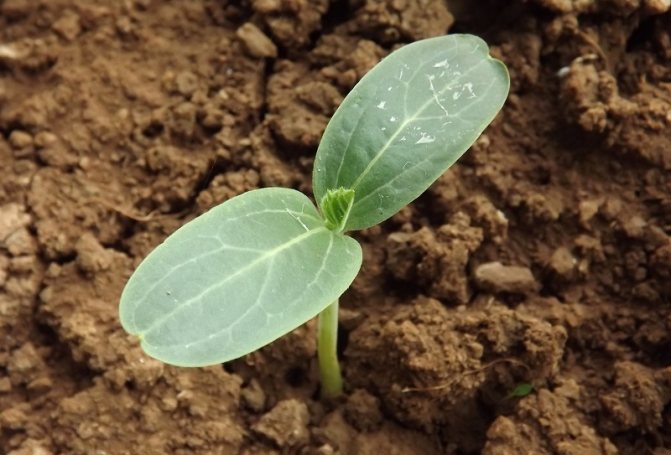

Due to the dense shell, seeds germinate for a long time
Planting in the ground or seedlings
For direct planting, shallow holes are dug into the ground at a distance of 1.5-2 m. A little humus and ash are poured there, water is poured, and then 2-3 seeds are laid out in each hole. Then they cover it with earth, and water it again. It is advisable to plant the culture in a sunny, windless place.
Separate small containers should be used for seedlings, since the sprouts do not tolerate picking well. The substrate is suitable for universal use. Planting is carried out to a depth of 1.5-2 cm. Care consists in regular watering, maintaining the temperature and lighting. The seedlings are moved to the garden bed when the risk of night frosts passes.
Care Tips
There are no special care requirements. The main activities are watering as the soil dries up, loosening and feeding no more than 2 times during the entire season. When several true leaves appear, complex fertilizers with nitrogen are applied under the bush, during flowering - a potassium-phosphorus complex.
So that the vines do not grow much, they are pinched. For each lash that has reached a length of 1.5-2 m, the top and extra ovaries are broken off, leaving no more than 5-6 fruits on the bush.
As the flowers open at night, pollination problems can occur. If you see that there are few ovaries, take a brush and run it over the stamens and pistils of the flowers alternately.
Author's advice
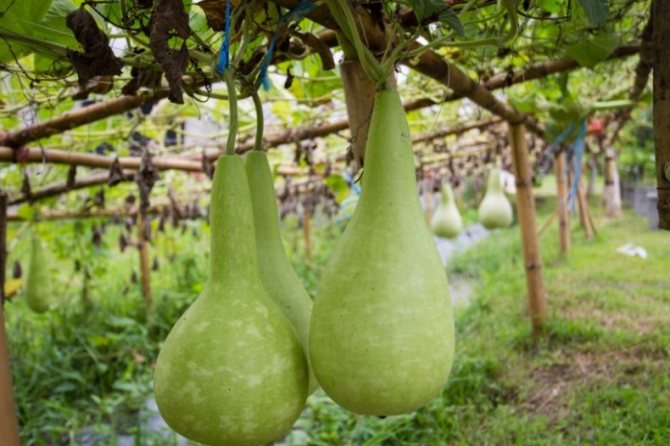

Vegetable can be grown on supports
Growing lagenaria from seeds for seedlings
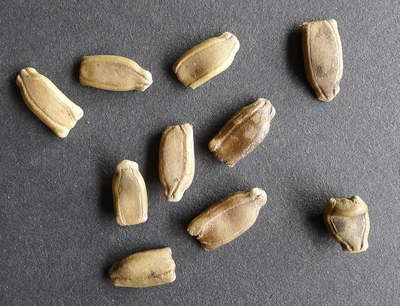

Bottle gourd lagenaria seeds photo
Lagenaria is cultivated similarly to marrow. In the conditions of central Russia and to the north, it is necessary to grow seedlings, and in the south, you can sow seeds directly into open ground.
Sowing for seedlings should be carried out a month before the planned transplant in open ground. It usually falls in the second half of May, when relative warmth is established. The seeds have a very strong and thick shell, so they must first be soaked and germinated. We leave them in warm water overnight, and then keep them in wet sawdust for about 7 days, maintain the temperature at 25 ° C.
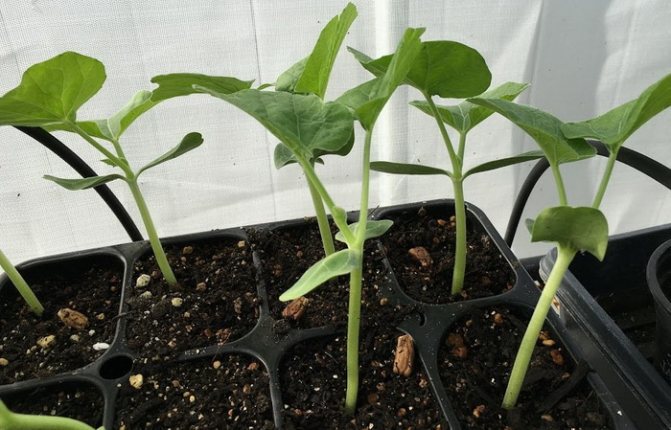

Seedling bottle gourd photo
- When the seeds hatch (the dense peel will simply burst and the sprout's nose will appear slightly), plant them in separate containers, being careful not to damage the sprouts, otherwise they will not sprout. Planting depth 2-3 cm, moisten by spraying from a fine spray.
- Provide diffused lighting and warmth to the seedlings, you can cover the cups with cling film.
- Seedlings will appear after a week.
- Experienced gardeners use the following trick: they soak the seeds in warm water for about a day, and then carefully open the doors with pliers. After manipulation, the seeds are planted as described above.
- Lagenaria seedlings should be looked after in the same way as for vegetable marrow or cucumber seedlings.
- With the emergence of seedlings, we remove the shelter, maintain warmth and sufficient lighting.
- Water regularly, but gently, avoid stagnation and moisture on the plant itself, so as not to provoke rotting.
- Be sure to need a long daylight hours of at least 12 hours. If this condition is not met, arrange additional lighting.
- To prevent the seedlings from stretching, use the "Krepen" growth regulator and the like: as soon as you see overgrowth, be sure to process the plants according to the manufacturer's instructions.
Cooking applications
The main application of lagenria is, of course, cooking. Only young fruits are eaten, since as it ages, the pulp begins to taste bitter. The young vegetable tastes like zucchini, so the recipes are very similar. You can cook warm salads, vegetable stews, omelets, all kinds of casseroles, squash-type caviar, stuffed dishes, and make preparations from the product. We offer a couple of recipes for cooking delicious dishes.
To prepare a casserole, you need the following ingredients:
- 600 g of fruit;
- 200 g sour cream;
- 200 g of hard cheese;
- 2-3 cloves of garlic;
- some butter;
- salt, spices.
Cut the fruits into thin (about 1 cm) rings and blanch in salted water for 5 minutes. Grate cheese, chop garlic and mix with sour cream. Grease a casserole dish, lay the lagenaria in layers, smear with sour cream and sprinkle with cheese so that the top layer is cheese. Bake at 180 ° C until golden brown.
To prepare vegetables stuffed with meat, you need the following ingredients:
- 0.5 kg of long fruits of lagenaria;
- 0.5 kg of minced meat;
- 1-2 carrots;
- 2 medium onions;
- 100 g sour cream;
- 100 g of cheese;
- some vegetable oil;
- salt and pepper to taste.
Cut the lagenaria into pieces 4-5 cm long, cut the middle, dip the blanks in boiling salted water for 3-5 minutes. Stew the grated carrots and chopped onions in vegetable oil until soft. Combine stewed vegetables with meat, add salt, pepper, mix everything and fill the workpiece with minced meat. Cover the form with foil, lay the vegetables tightly to each other, pour with sour cream and sprinkle with grated cheese. Bake until golden brown.
Lagenaria fruits can be cut in parts directly on the bush. The cut will not rot - it will simply dry out, after which the vegetable will continue to grow further.


Vegetable casserole with minced meat


Vegetable soup
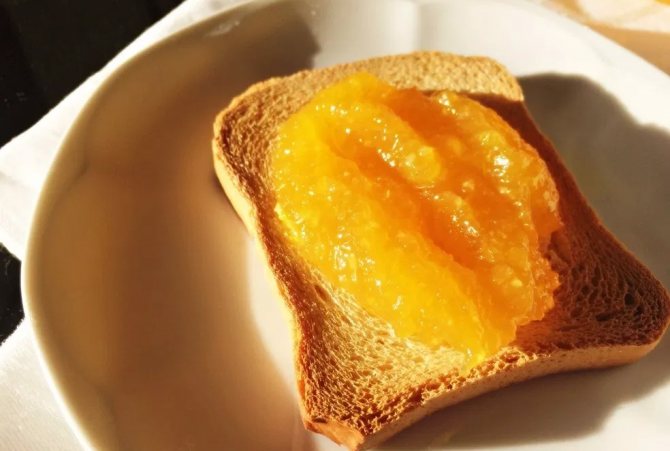

Jam from Lagenaria
Original DIY ideas for handicrafts from pumpkin lagenarii
Due to its ease of care and cultivation, it often grows in gardens and vegetable gardens. Usually it is grown by gardeners who prefer plants that are undemanding to care for. Dishes from Lagenaria are very healthy, because gourd gourd is rich in vitamins.
However, not everyone knows that, in addition to delicious dishes, very interesting crafts can be made from this original pumpkin. Original souvenirs with your own hands from a gourd pumpkin will serve as an excellent gift for family and friends and will take a worthy place at a fair or exhibition. You can make original dishes from gourd-gourd. Sometimes interesting toys are made from it. And you can also make unusual Christmas tree decorations from it.
The use of lagenaria for decorative purposes
The peel of ripe fruit is firm and waterproof. This property allows the use of lagenaria in decorative arts. The inhabitants of Africa, Latin America and the island states have long learned to make kitchen utensils, musical instruments, pipes and even toys from fruits. For decorative purposes, lagenaria is removed as late as possible, just before the frost. To build some kind of craft, the fruit must be well dried, then cut off the top, scoop out the pulp, and decorate the shell with a pattern.
The most common products from Lagenaria are all kinds of vessels, vases, jugs, containers for storing food. The solid surface of pumpkins is easily painted, varnished, you can burn out and create any patterns on it, the main thing is imagination. An unforgettable creative experience is guaranteed.
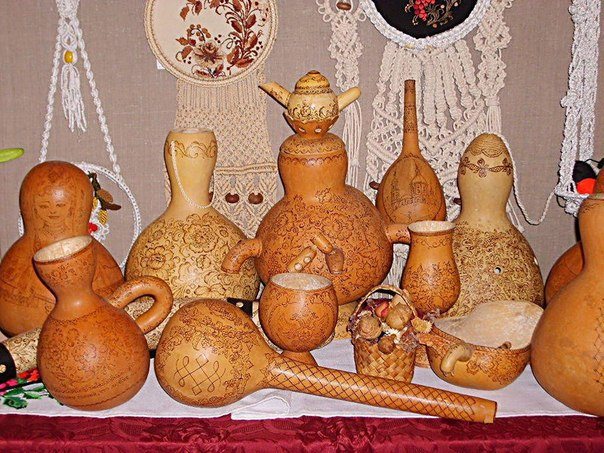

All kinds of vessels, vases, jugs are made from lagenaria
The fast-growing vine can be successfully used to decorate arches and fences. In literally a month, she will braid the structure and create a blessed shadow.
Lagenaria can be considered a unique vegetable crop. Its cultivation does not cause much trouble, and the harvest can be applied in many areas, from cooking to decorative painting. In addition, any housewife will be pleased to receive handmade dishes from natural materials as a gift.
Bottle gourd: crafts, decor options
Homemade Lagenaria pumpkin decorations look great as a garden decor. The dried fruit can simply be hung on a hedge or vine arch. You can go a more complicated way - make original lighting to decorate your garden.
Lamp
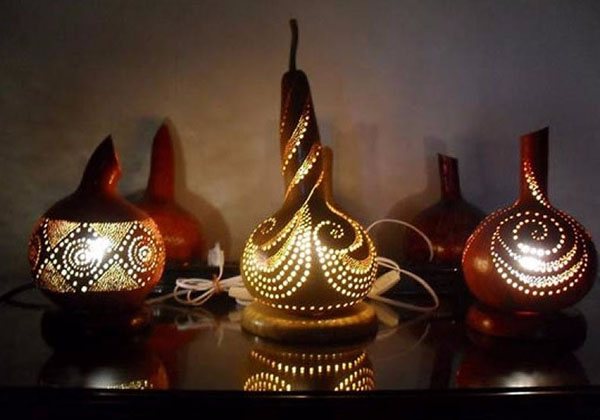

Let's start making the lamp:
- Take a small pumpkin.
- Remove the narrow section and the stem where the diameter matches the bulb holder.
- Saw off the opposite section of the pumpkin, making a shade-shaped blank.
- Remove all seeds and pulp.
- Draw a pattern on the surface of the fruit and cut it out with a jigsaw.
- Connect an electrical cable of the required section with a plug to the socket.
- Insert one part of the chuck into the narrow hole and fix it with the other part from the inside.
It remains only to screw in the light bulb and connect the lamp to the mains. In a similar way, you can easily make a table lamp or an original night light.
All work with electricity must be carried out in compliance with safety measures and only with a de-energized electrical system. It is better to entrust the work on connecting the products to the household power supply to a qualified electrician.
Bird feeders
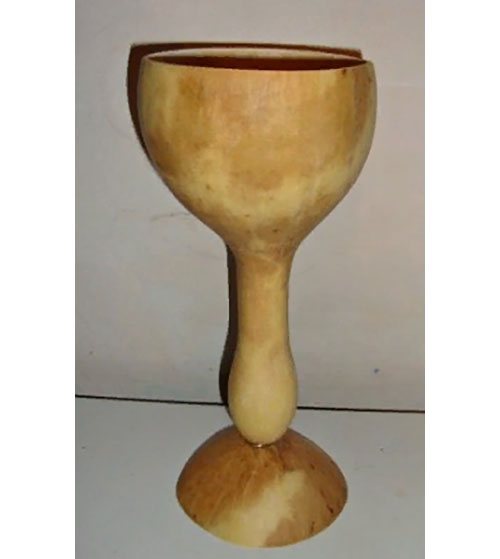

Do-it-yourself pumpkin dishes will adorn the interior of a modern kitchen decorated in ECO or Provence style. To make a glass from lagenaria, follow the instructions:
To decorate the product, you can use any technique: decoupage, painting with acrylics, burning.
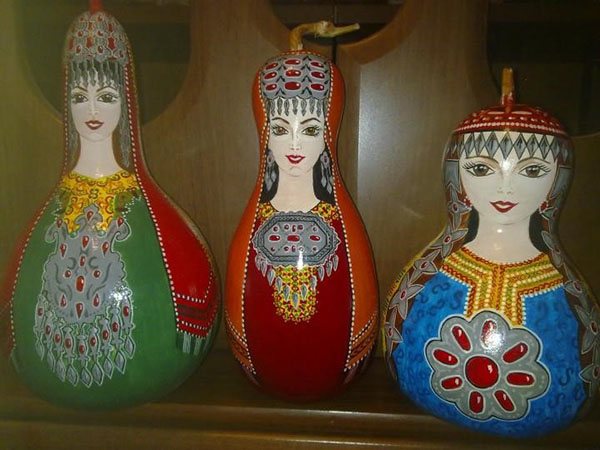

A very interesting idea is to make nesting dolls out of bottle pumpkin:
- Pick up several fruits of the same shape, differing from each other only in size.
- Remove the stalk and cut the fruit crosswise (except for the smallest one) into two pieces of the same size.
- Thoroughly peel the contents from the halves.
Read also: What are the materials for the fence, and which ones are better
It remains only to color the nesting dolls. The narrow part is the doll's head; the thickening will be her torso.
From this publication, you learned what handicrafts can be made from the lagenaria with your own hands, familiarized yourself with the options for harvesting, decorating the product and decorating the pumpkin at home. As you can see, everything is quite simple. The main thing is to show creative thinking and creativity.

